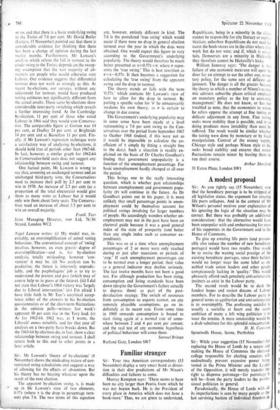Sir : Mr Lawson's 'theory of by-elections' (8 November) shows
the misleading nature of con- ventional swing calculations and suggests a way of allowing for the effects of abstention. But his theory has no bearing whatever upon the result of the next election.
The apparent by-election swing, s, is made up in Mr Lawson's view of two elements, 0.57T (where T is the drop in percentage turn- out) plus 7.6. The two terms of this equation
are, however, entirely different in kind. The 7.6 is the postulated 'true swing' which would occur if there were no drop in general election turnout over the year in which the data were obtained. One would expect this figure to vary according to the Government's underlying popularity. The theory would therefore be much better presented as s=0.57T+P, where P repre- sents the 'true swing.' This is best rewritten as P=S-0.57T. It then becomes a suggestion for calculating the 'true swing' from the apparent swing and the drop in turnout.
The theory stands or falls with the term '0.57T,' which contains Mr Lawson's view of how to allow for the drop in turnout. By putting a specific value for `10 he unnecessarily weakens his own theory, as P is certain to change in due course.
The Government's underlying popularity may in some sense have been steady at a level representing a 7.6 per cent swing to the Con- servatives over the period from September 1967 to Ocober 1968 (indeed, if this were not so it would be impossible to calculate the co- efficient of T simply by fitting a straight line to the data). Such a situation is readily ex- plained on the basis of Dr Charles Goodhart's finding that government unpopularity is a function of the unemployment percentage. For basic unemployment hardly changed at all over the period.
This brings one to the really interesting question, which is whether past relationships between unemployment and government popu- larity (e) will continue in the future. As Dr Goodhart points out in his paper, it is most unlikely that small percentage points in unem- ployment could by themselves account for political swings involving far larger numbers of people. He accordingly wonders whether un- employment may not in the past have been an electoral guide because it was a good general index of the state of prosperity (and better than any single index such as consumer ex- penditure).
This was so at a time when unemployment percentages of 2 or more were only reached during or just after recessions or periods of `stop.' If such unemployment percentages are to be normal over a longer period, their value as a general indicator may decline seriously. The last twelve months have not been a good test. For although production has been rising, consumption and living standards have been down (despite the Government's failure actually to depress them) as part of the post- devaluation strategy. The switch of resources from consumption to exports cannot, on any remotely plausible assumptions, go on in- definitely at its recent rate. From some time in 1969 onwards consumption is bound to start rising again at a normal rate of some- where between 2 and 4 per cent per annum; and the real test of any economic hypothesis of political behaviour will come them.


































 Previous page
Previous page